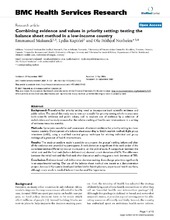Combining evidence and values in priority setting: testing the balance sheet method in a low-income country
Peer reviewed, Journal article

Permanent lenke
https://hdl.handle.net/1956/2665Utgivelsesdato
2007-09-24Metadata
Vis full innførselSamlinger
Originalversjon
https://doi.org/10.1186/1472-6963-7-152Sammendrag
Background: Procedures for priority setting need to incorporate both scientific evidence and public values. The aim of this study was to test out a model for priority setting which incorporates both scientific evidence and public values, and to explore use of evidence by a selection of stakeholders and to study reasons for the relative ranking of health care interventions in a setting of extreme resource scarcity. Methods: Systematic search for and assessment of relevant evidence for priority setting in a lowincome country. Development of a balance sheet according to Eddy's explicit method. Eight group interviews (n-85), using a modified nominal group technique for eliciting individual and group rankings of a given set of health interventions. Results: The study procedure made it possible to compare the groups' ranking before and after all the evidence was provided to participants. A rank deviation is significant if the rank order of the same intervention differed by two or more points on the ordinal scale. A comparison between the initial rank and the final rank (before deliberation) showed a rank deviation of 67%. The difference between the initial rank and the final rank after discussion and voting gave a rank deviation of 78%. Conclusion: Evidence-based and deliberative decision-making does change priorities significantly in an experimental setting. Our use of the balance sheet method was meant as a demonstration project, but could if properly developed be feasible for health planners, experts and health workers, although more work is needed before it can be used for laypersons.